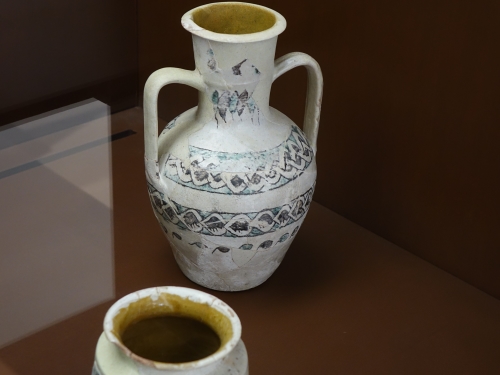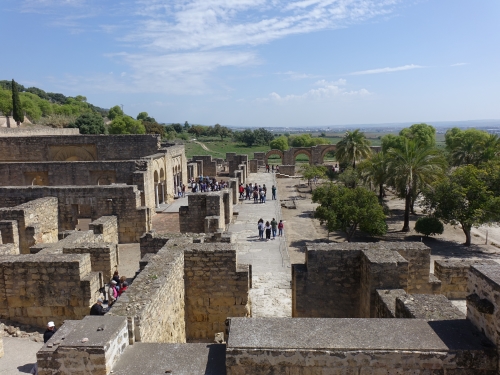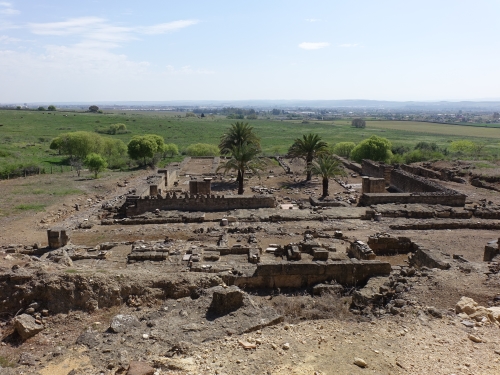Blog WHS Visits
WHS #697: Medina Azahara
Spain’s Medina Azahara won its WH status as recently as 2018 (after having been on the Tentative List for 3 years). It wasn’t a well-known destination before that, as can be read from the previous reviewers on this website which all visited a few years earlier at most. The site has been excavated from 1910 on and has been a Spanish national monument since 1923, but the real boost in visitor numbers came after the opening of the award-winning on-site museum in 2009. When I visited, on a Saturday in late March 2019, there were literally hundreds of visitors around and the overflow parking lot was in use. A significant part of the daytrippers consisted of Spanish muslims.
Somehow not everything adds up here regarding visitor management: strapped for cash some restorations like the one of the Rich Hall have slowed down, but there still is no entrance fee charged. Other prominent Andalusian landmarks such as the Alhambra and Cordoba’s mosque-cathedral cost 14 and 10 EUR respectively. So why does Medina Azahara not profit financially from the high visitor numbers? The only paid aspect is the bus ride to the archaeological site, but this money seems to go directly to the bus company.
Nevertheless, a visit is worthwhile and I spent about 2.5 hours at the site. The museum is an attraction in itself. I especially liked the glazed ceramics with their green and manganese decorations (I had to look that last one up – it’s a metal). They were made specifically at (or at least: for) Medina Azahara’s entourage. I also appreciated that at the end of your tour along the exhibitions you pass two huge storerooms where many more findings are kept. This as a silent reminder that much more work has to be done.
The archaeological site itself I found larger and more impressive than I had expected. When it was rediscovered for the first time – in the 16th century by a local monk – it was thought that they were Roman ruins. This seems understandable as the ground plan resembles Pompeii or other relatively intact Roman cities. Medina Azahara was built on a series of man-made terraces, with the Caliph’s palace at the top. These days as a tourist you walk down from top to bottom. The narrow street pattern is still present and it really feels like you are walking in a city. There are squares, gardens, official buildings and smaller living quarters for the servants. The presence of palm trees and water in the pools does add to the general atmosphere of a liveable, rich city.
Some parts have been beautifully restored, or better said: re-assembled as if it were a large jigsaw puzzle of where only half of the pieces were available. This was most prominently done at the various semi-circular arches, which were gateways and entrances to main buildings. The best example is found at the Europa Nostra award-winning House of Ya’far. The difference between original work and later additions is clearly visible, apparently a good practice in restoration. The authenticity of the whole was satisfactory to the ICOMOS consultants.
Medina Azahara has come a long way over the past decade. I wonder how it will look like in 10 years. Time will come that the Rich Hall and its adjacent gardens will also be accessible, lifting the whole visiting experience up to another level.
Els - 7 April 2019
Comments
Els Slots 7 April 2019
The whole area (Rich Hall plus gardens) is fenced off (there's a stone wall in between this part and the rest of the site, you cannot even come close). The AB ev of 2018 says "the conservation of some buildings of the Qasr have been delayed by financial restrictions. The main financial resources come from the Junta de Andalusia that covers the current expenses and minor conservation works. The large projects of building conservation cannot be carried out solely with the current budget. Special financial support by external institutions is required."
Solivagant 7 April 2019
I missed the Article link -
https://www.wmf.org/project/salón-rico-palace-medina-azahara
This from 2011 indicated that it was only supposed to be 24 month project -
https://www.wmf.org/sites/default/files/press_releases/Albi-Salon-Rico.pdf
Solivagant 7 April 2019
In my review I wasn't sure if the "Rich Hall" (Salon Rico) and gardens were just temporarily "blocked off" - but you seem to have concluded that the entire area is closed for some time until "restoration" is "complete". This article indicates that the WMF has been involved since 2011 but isn't clear whether it considers its work finished or not (it uses both "past" and "present continuous" tenses!). And I can find nothing on the Web indicating when the Hall might be open . Also it isn't clear to me whether the Gardens have to await completion of the Rich Hall.. Did you gather anything? Months ....Years ..... Unknown into the distance?


